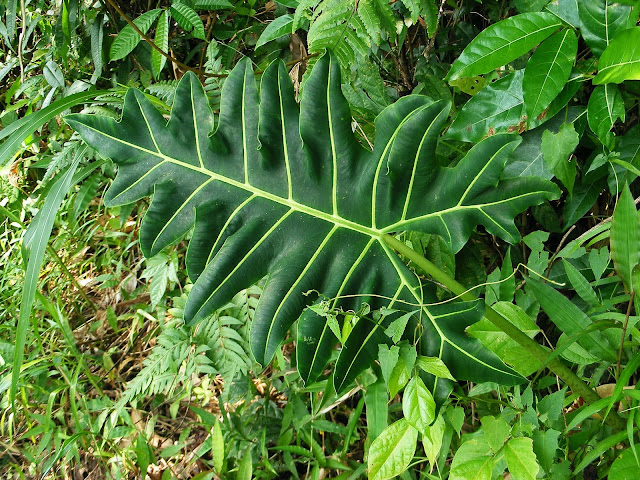The tall, 'tattered', and splendid Alocasia portei
One of those plants that I usually see and admire from my frequent hikes around my area is Alocasia portei, a large-growing aroid that can be quite common where they occur. There are apparently two forms known to exist, one with plain green leaves and greenish petioles with thin bandings and the other with pale green veining with petioles that eventually become very dark, and whose juvenile plants bear striking resemblance to A. sanderiana. Both forms are found naturally in the mountains within my area, but their populations do not seem to overlap.
In the wild, A. portei appears to favor more exposed sites such as road embankments and trails, with leathery leaves that are held sub-erect and gives the impression of reaching out into the light.
Really old individuals eventually develop a thick stem in the same manner as those found on the more common and widespread A. macrorrhizos, and truly spectacular examples reach to about 3 meters in height and have practically black petioles and very highly undulate leaf lobes. I have been seeing these things in the wild for close to two decades now, but every time I see one, it's almost like the first time. Not surprisingly, these plants have found their way into specialist gardens both in the Philippines and abroad, with hybdridizers using this species to produce hybrids with dramatically cut leaves.
Anyway, I have always wondered why those leaves look like that. One common theory advanced for plants with deeply cut or irregularly-shaped leaves is that it helps in the concealment of the plants from potential herbivores by breaking up the outline, but given how big these plants grow, I am hesitant to believe that bearded pigs can ever reach out to that foliage, although they can make short work of those corms if they wanted to. Then again, there was a time when the Philippines had elephants in its forests so...
The big question now is: why is it that I do not keep this species? A massive specimen with those wacky leaves should have a commanding presence in my backyard but I am still yet to commit to one. Or maybe because these are quite common in my area and frequently encountered that I am not compelled to maintain one. But, who knows?







Definitely a unique Alocasia. I recently saw a greenhouse with one of these beauties and have since been doing my homework.
ReplyDeleteIs there such a thing as a broad-leaf A. portei?
ReplyDeleteOooh, a tricky question to answer. Yes, there is. But how broad? Because there is another plant that is midway in appearance to A. macrorrhizos and A. portei.
DeleteI actually never knew the Portei had 2 variants, I cannot seem to find a side by side comparison between the two!
ReplyDelete